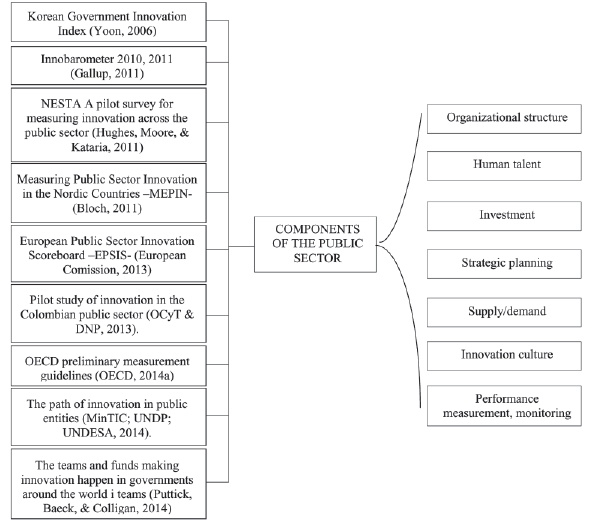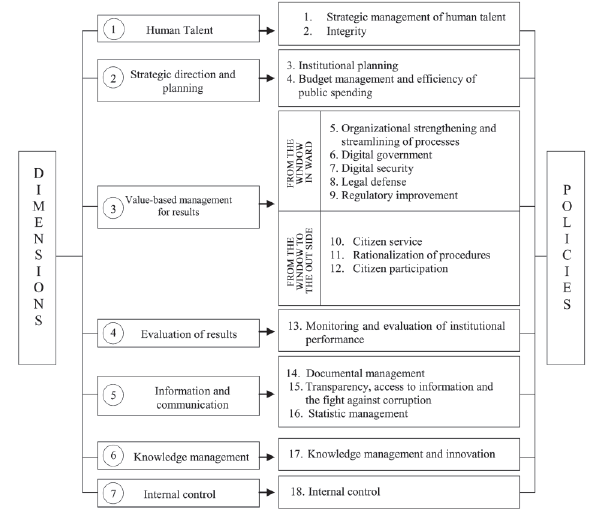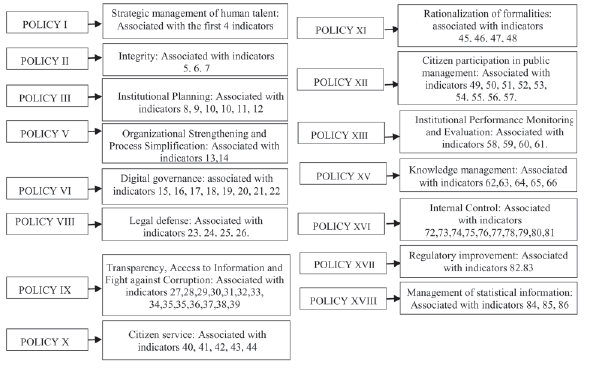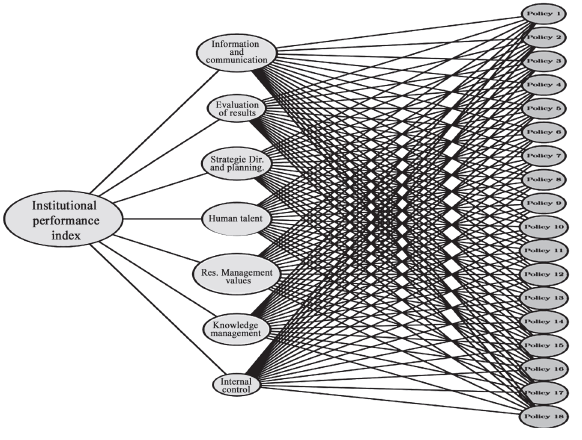INTRODUCTION
Innovation is constituted as a process that allows the improvement of the conditions in which a good or service is produced or marketed, a process is developed, and the positioning of a company or institution is generated (Bogers, Chesbrough & Moedas, 2018; Rajapathirana & Hui, 2018), thus mobilizing an ecosystem (Suominen, Seppânen & Dedehayir, 2018) that allows the integration and articulation of different actors (Liu & Stephens, 2019) whether public or private in an economy.
In the public sector, the innovation that is carried out is essentially aimed at solving problems of general interest (Torfing, 2018), because it represents high levels of complexity and uncertainty and directly or indirectly affects the quality of life of citizens at the local, territorial and national levels.
Hence, countries seek to strengthen the management of their public entities (Höglund, et al, 2018), since they constitute the support, scaffolding and mobilizing agent of their economic development.
Colombia, for example, has the goal of positioning public innovation as the axis of its growth strategy, as observed in the National Development Plan 2020-2022: «Pact for Colombia, Pact for equity». This program has sought to strengthen innovation laboratories to understand the needs of citizens, design and deliver new and better public services, improve the internal management of organizations to operate more efficiently and increase citizen confidence.
To this end, it has been required to work in a systemic and multidimensional way in the management of public innovation, which led to the creation of the Integrated Planning and Management Model - MIPG -, which through periodic measurements and identifies progress in institutional efficiency.
This study measured and analyzed the role of innovation in the institutional performance of public entities at the territorial level in Colombia during 2018 and 2019. Thus, the document is divided into two parts: the first presents a theoretical context on public innovation in Colombia; the second presents the methodology and results obtained from the analysis of the Single Management Progress Report Form, using the known Item Response Theory Model, specifically the Graduated Response Model -MRG; finally, the conclusions of the research are presented.
THEORETICAL FRAMEWORK
The concept of innovation has been widely studied over the last few years. There are different authors who refer to its importance in the generation of a product and in the provision of a service (Tian, Deng, Zhang & Salmador, 2018; Vendrell-Herrero, Bustinza & Opazo-Basaez, 2021; Hatta, Rachbini & Parenrengi, 2018), as well as in the improvement of processes (Dziallas & Blind, 2019; Alshanty & Emeagwali, 2019), techniques (Knight, Fitton, Phillips & Price, 2019), branding (Heinberg, Katsikeas, Ozkaya & Taube, 2020), research (Hinings, Gegenhuber & Greenwood, 2018), patent development(Raghupathi & Raghupathi, 2017), among others.
Thus, in Colombia, the public administration has promoted innovation initiatives, considering it a key factor for development (Busom & Vélez-Ospina, 2017; Ramírez, Gallego & Tamayo, 2020) based on institutional relationships and the focus on challenges and priorities. These initiatives seek to respond to the processes that arise as a result of globalization, to the need to consolidate participatory spaces for social control (Casanova, Hernández & Quintero, 2019) and with transparency of Public-Private alliances (Cañeque, 2007), to the concentration of the population in urban environments and to many other difficulties that affect governance (Hernández & Pérez, 2016) and diminish both trust in the authorities and the possibilities of development of the territories (González & Lutsak-Yaroslava, 2017).
Hence, the base conditions for these initiatives to have the opportunity to materialize in concrete results are given to a greater extent by the administrative efficiency of public entities, taking into account aspects related to human capital, information management, citizen attention, among other aspects related to the improvement of the quality of life of the country's inhabitants.
Authors such as Navarro (2020) indicate that the implementation of innovation-oriented policies can have an impact on the growth and productivity of the nation. Therefore, it becomes a necessity which must have a direct relationship with the General Budget, in order to relate the expenses required for its operation.
For five decades, the Organisation for Economic Co-operation and Development (OECD) has conducted studies aimed at strengthening the innovation strategies of member countries and in pursuit of this objective has generated metrics associated with economic performance, investment in infrastructure, public innovation, particularly in the management of public policies, among other aspects (Blind, 2012; Sørensen, 2017). Beyond the fulfillment of global innovation objectives, these measurements are oriented to recognize the way in which initiatives are managed, developed, implemented and sustained in the different sectors of the economy (Sørensen & Torfing, 2012).
Although the public sector represents a fundamental context for measurement because its policies help mobilize actions aimed at fostering innovation in the sectors, the challenge is to work on measurement systems that can be analogous to those employed in the business sector (OECD/Eurostat (2018), due to its organizational, regulatory and cultural particularities.
For this reason, the OECD Public Innovation Observatory has generated studies in which the need to establish innovation strategies and involve them in public management, according to the new global challenges that emphasize the socioeconomic, biological and environmental contexts, is evident (OECD, 2019).
In this sense, countries have generated policies that incorporate elements in which public innovation becomes necessary to respond to the needs of the population. Thus, for example, in Colombia in 2019 it signed the declaration of innovation for the public sector with the OECD, in order to focus its efforts on strengthening public management, so that it incorporates innovation in a cross-cutting manner and structures systemic portfolios that in turn support citizens to innovate in their productive and social environment OECD (2019).
To materialize this commitment, the declaration focuses on five areas of work:
Facilitates the work and relationship with public and private actors.
Hence, the National Planning Department (DNP) and the Administrative Department of the Public Function, together with the regulatory entities, have developed measurements and instruments to strengthen the performance of public entities, monitor their restrictions and strengthen their overall innovation processes.
Thus, with the aim of strengthening the measurement schemes of the conditions that facilitate public innovation, the Colombian Observatory of Science and Technology -OCyT-, together with the DNP in 2016, analyzed the measurement models of innovation management in various sources from 23 countries and finally took up key aspects of 10 of these:

Note: Prepared by the authors based on the references listed in the figure.
Figure 2 Public sector components essential for public innovation.
The central aspects of these studies coincide with the one conducted by Petkovsek & Cankar (2013) in which they highlight the following central elements in public innovation, which should be systematically stimulated and measured according to institutional size and complexity. Table 1.
Although the Colombian government had already worked on the measurement and strengthening of these aspects as of document CONPES 3582 of 2009; in 2015, as a result of a measurement by the World Bank (2015), weaknesses in institutional articulation continued to be evidenced due to overlapping functions, instruments, low systemic vision and low efficiency in public spending, a scenario that, according to this study, is exacerbated in the territories.
Therefore, the measurement of the institutional performance of public entities requires a system of indicators specific to the public sphere, given that this is not given by economic profits or losses, as is the case with private management (Tadeu & Silva, 2014).
In public entities, it is essential to verify the measurement parameter, associated with the normative and methodological guidelines that are oriented by the corresponding governing bodies, on these parameters compliance is looked at according to the evidence.
The institutional framework of the performance measurement system of public entities in Colombia is headed by the Administrative Department of the Public Function, which collects the guidelines of the governing bodies, captures the information of the entities on their performance, consolidates and mobilizes, together with the governing bodies, measures to improve management. Cubides J., Navas, F., Ortiz, D., & Rico, A. F. (2020).
In this regard, Bonnefoy & Armijo (2005) state that it is essential for countries to have performance indicators integrated into a measurement system that seeks to evaluate key aspects such as the type of public organization, the products and services associated with its mission, the benchmarks for comparison, the information collection scheme and the statistical guidelines for analyzing the results.
Thus, the Administrative Department of the Civil Service has developed a system for measuring institutional performance, which is carried out annually based on the information recorded by public entities in the Single Management Progress Report Format - FURAG -.
The questionnaire is organized according to the structure of the Integrated Planning and Management Model - MIPG, in 7 dimensions and policies, as illustrated in Figure 3.

Note. Own elaboration base don www.funcionpublica.gov.co
Figure 3 Integrated Planning and Management Model.
In this way, the entities must report, for each of these policies, the progress made in complying with regulatory and methodological guidelines. This information is statistically processed to calculate the Institutional Performance Index - IDI -.
Likewise, in the goals of the National Development Plan, there are defined aspects of improvement at the national and territorial level, for each four-years. This measurement system unifies and harmonizes the previous criteria associated with the internal control system, the quality management system and the administrative development system.
Therefore, this process is related to the inclusion of new management policies, assuming the challenges and risks faced. According to Bonnefoy & Armijo (2005), some of them are a) the organizational culture of public entities that do not value the process positively; b) the lack of continuity in the leadership of the authorities; c) the weakness in human capacities to assume the activities involved in institutional evaluation; and d) the lack of interest of public servants and their entities to follow the evaluation guidelines in their planning, execution and information management.
Another element to be taken into account in the measurement processes is the existence of an institutional management policy of the Integrated Planning and Management Model, which evaluates knowledge management and innovation. This is a policy that has an impact on all the other activities evaluated by the model illustrated in Figure 3, under which national and territorial public entities must generate, share, systematize and disseminate knowledge to facilitate its appropriation and use.
Its transversality makes it possible to identify collateral aspects of other management policies that may affect innovation in public entities, so analyzing the way in which the indicators behave with each other makes it possible to recognize opportunities for institutional improvement that may have an impact on the process of measuring institutional performance and, in the specific case of interest, on public innovation.
METHODOLOGY
Performance measurement can become a very useful metric in the optimization of business improvement and expansion strategies, as well as territorial; because it is a periodic record that determines when certain actions enhance desired results.
Several entities, however, not satisfied with the monitoring of their capabilities, require a reliable and uniform comparison to establish a point of comparison with the general level of their competitors, so governmental entities inspired by this need required to establish general measurement scales for a given context.
Thus, although innovation and development metrics are increasingly better implemented, the parameters with which they are calculated depending on factors that generate uncertainty and impact the desired result.
ENTITY STUDIED
In 1993, the Colombian government driven by the interest in providing public entities with a tool that would allow them to detect strengths and weaknesses in their management and thus establish optimal improvement policies created the Institutional Internal Control System.
In 2017, it was possible to implement a single uniform measurement system for administrative development and quality management: the Institutional Performance Index (IDI). This instrument makes it possible to annually measure the management and performance of public entities of the national and territorial order within the framework of the criteria and thematic structure of the Integrated Planning and Management Model.
The entity in charge of this measurement is the Administrative Department of the Public Function and it is based on the analysis of the data collected through the registration of the Single Management Progress Report Form. For the calculation, a known Item Response Theory Model is implemented, specifically the Graduated Response Model - MRG.
DESCRIPTION OF THE DATA
The results generated by the 2020 Institutional Performance Measurement generated a characterization by territory and nation. At the departmental level, a study was registered with 4,944 data, with categories according to their organic classification and specifically focused on the executive branch. Of this information, there are 2,968 records, representing 60% of the data.
Each database consists of 112 quantitative variables, represented by values between zero and 100 that indicate the percentage obtained by the associated entity. The first in the file is the Institutional Performance Index (IDI), which is accompanied by 7 dimensions on which it directly depends. These are Human Talent, Strategic Direction and Planning, Managing for Results with Values, Results Evaluation, Information and Communication, Knowledge Management, Internal Control.
In the same way, each dimension depends directly on 18 policies and each policy depends on 86 detailed indexes per policy.
DATA PROCESSING
For the debugging of the information, only the non-numerical columns were left: SIGEP Code, Entity, Organic Classification, Legal Nature, Department, Municipality, Municipal Category, Municipal Cluster, PDET Municipalities. The purpose of this is to adequately identify each entity in the study, if necessary.
On the other hand, for the numerical variables, only the names of the variables were modified, in order to adequately compile the identification algorithm.
The institutional performance index was renamed as (y), each dimension was renamed (x_n) with n being an integer between 1 and 7, the 18 policies were renamed from (p_m) with m being an integer between 1 and 18 and finally the indexes by policies with j being an integer between 1 and 86.
SOLUTION APPROACH
Due to the significant interaction between the variables, the model required to satisfy the objective set out should take into account the relationships between the values of the indexes, therefore, a multivariate regression method is required to associate quantitative quantities to the interactions in order to identify the most representative ones.
Thus, a Structural Equation Model (SEM) was implemented to model the dynamic behavior of these variables. This was created in the mid-20th century by Sewall Wright, and refers to a diverse set of tools and approaches to describe and estimate causal relationships between variables, whether observable or latent (Igolkina & Meshcheryakov, 2020).
The subject of observable variables refers to the set of phenomena to which quantitative quantities can be associated, as opposed to latent variables which cannot be obtained by empirical measurement but are inferred by analytical or stochastic methods.
The theoretical foundation of structural equation models is based on the minimization of the weights of the following equation:
Where n is the number of latent variables, the number of the observed variables participating in the relationships with the latent variables is denoted by x and the observable variables by y. The values d and c are error vectors that improve the approximations and finally B, A are matrices that hold the linear approximation parameters.
Currently, the effectiveness of structured models has been established for measuring general satisfaction about public transport (Allen et al., 2020), intention to use social networks (Salloum et al., 2021) and for establishing the relationship between human mobility and Covid 19 infections (Xiong et al., 2020).
DESCRIPTION OF THE STUDY
For the design of the model, the relationships determined by the Institutional Performance Index (IDI) were established, to which a latent variable will be assigned, which will be related to the 7 dimensions. This indicates that the new variable yc intends to explain the index and is explained by the 7 dimensions.
Similarly, each dimension will be assigned a latent variable which will be explained by the 18 policies and will seek to estimate each dimension, and each policy will be associated with an indicator as follows:
RESULTS
Figure 6 shows a sketch of the relationships originated by the calculation of the Institutional Performance Indicator. However, due to the enormous number of policy dependencies, the depth of the tree was only extended to the third branch (policies).
Also, the relational dependencies of each indicator generate a multitude of permutations among the variables, making it difficult to identify the relevance of each construct in the final development of the institutional indicator.
Each line segment indicates a relationship that is not necessarily linear and defines a set of unknown values that represent the contribution of these indicators to the policies or indexes of which they are a part.
The analysis shows that according to the estimator generated, the most representative dimensions of the Institutional Performance Index (IDI) are: human talent, knowledge management, internal control, management for results with values and evaluation of results.
Likewise, for human talent, organizational strengthening and simplification of processes, knowledge management and internal control are determined as significant for its development.
Internal control has as representative the monitoring and evaluation of institutional performance, while knowledge management, strategic management of human talent is significant.
Management for results with values has as representative variables: organizational strengthening and process simplification, legal defense, regulatory improvement and statistical information management. The evaluation of results has document management as a significant variable.
Thus, it is evident that to obtain an effective policy that promotes good practices in public innovation, it is necessary to strengthen these dimensions, especially because they are the ones that have the greatest impact on the population and, in general, on the economic sectors.
Thus, the development of strategic plans generated from the established public policy, the availability of human resources to strengthen the processes with their knowledge, and the consolidation of solid work teams that improve processes and dynamize the proposed activities. This will facilitate the generation of indicators that promote the measurement and control of the proposed objectives.
On the other hand, focusing the study specifically on the most relevant policies obtained previously, we have the following:
Policy 1: The indicators, quality of strategic planning of human talent, efficiency and effectiveness of a meritocratic selection of human talent, development and welfare of human talent in the entity and assisted disengagement and retention of knowledge generated by human talent are relevant.
Policy 5: The indicators, organizational effectiveness and optimal management of support goods and services are relevant.
Policy 8: The indicators, prevention of legal malpractice, management of legal proceedings, institutional capacity to exercise the strategic information for decision making are relevant.
Policy 13: Indicators, effective monitoring and evaluation mechanisms, documentation of monitoring and evaluation, focus on citizen satisfaction, continuous improvement are relevant.
Policy 14: Indicators, quality of the strategic component, quality of the records management component, quality of the documentation component, quality of the technology component, quality of the cultural component is relevant.
Policy 15: The indicators, knowledge management and innovation planning, knowledge generation and production, generation of tools for the use and appropriation of knowledge, generation of a culture conducive to knowledge management and innovation, institutional analytics for decision making, are relevant.
Policy 16: Indicators, enabling environment for the exercise of control, strategic risk assessment, effective control activities, relevant and timely information and communication for control, systematic and improvement-oriented monitoring activities, independent evaluation of the internal control system, strategic line, the first line of defense, the second line of defense, the third line of defense, are relevant.
Policy 17: Indicators, planning, design and public consultation, final standard, monitoring and evaluation are relevant.
Policy 18: Indicators, statistical planning, strengthening of administrative records, statistical quality, are relevant.
CONCLUSIONS
The implementation of innovative activities and processes in the public sector demands political commitment and interest, which requires constant work, the development of research processes that strengthen established policies, organizational strengthening, access to information, strategic plans generated with clearly defined objectives, as well as control tools that allow measuring the management developed.
Therefore, this research showed the importance of human talent in public innovation, the attitude they assume, the integration generated with the processes, the participation in multidisciplinary and multisectoral teams and the attitude open to change.
Likewise, there is evidence of the need to implement innovation processes based on an established policy, with the collaboration of all to achieve a shared solution, making it scalable and maintaining sustainable leadership in public organizations so that in the short-, long- and medium-term internal processes are more efficient, responsible and effective.
Another essential factor is the implementation of technology to obtain effective results. This has become an essential factor for obtaining good performance, efficient processes in organizations and for providing solutions to the problems identified in the public sector. This allows the conditions in which services are provided to be optimal and to respond innovatively to the requirements of society.
Finally, this study detects that the monitoring and measurement of performance, continuous improvement, the implementation of indicators that allow internal control and monitoring, transparency and the provision of information, are essential elements in the construction of progressive development in Colombian public institutions.



















